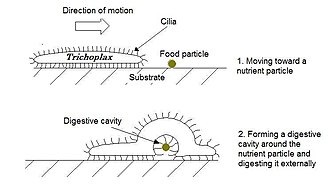Placozoa
Placozoa are a phylum of simple, multicellular, non-symmetrical animals consisting of a single species, Trichoplax adhaerens. Discovered in the late 19th century, Placozoa are unique due to their simple body plan, lacking any organs or defined tissues such as nerves, muscles, or gut. They are the simplest in structure of all non-parasitic multicellular animals. This simplicity makes them a subject of interest in the study of evolution and the origin of multicellularity in animals.
Description
Placozoans are small, flat, and roughly disc-shaped animals, usually less than 3 mm in diameter. They have a benthic lifestyle, living on the underside of rocks or other submerged surfaces in warm seas. Their bodies are composed of two layers of cells: an upper layer (or epithelium) and a lower layer, with a few different cell types between them. They move and feed by gliding along surfaces, secreting digestive enzymes to break down microalgae, their primary food source.
Reproduction
Reproduction in Placozoa is primarily asexual, through a process known as fission or budding. However, there is evidence to suggest that they can also reproduce sexually, although this has been observed less frequently. The exact mechanisms of their sexual reproduction and the development of their embryos are still subjects of ongoing research.
Genetics and Evolution
The genome of Trichoplax adhaerens has been sequenced, revealing insights into the evolutionary history of multicellular organisms. Despite their simple structure, Placozoans possess a relatively complex genome, with a number of genes associated with multicellularity, cell signaling, and cell adhesion. These findings suggest that the simplicity of Placozoans is not due to a lack of genetic complexity but may result from a secondary simplification from more complex ancestors.
Ecology
Placozoans are found in tropical and subtropical waters around the world. They are usually associated with hard substrates, such as the undersides of rocks, but can also be found on artificial substrates. Their ecological role is not well understood, but they are considered to be part of the biofilm community, contributing to the breakdown of organic matter.
Research and Significance
Placozoans are of significant interest to scientists studying the evolution of multicellularity and the origins of animal life. Their simple body plan and the presence of genes associated with more complex organisms provide a unique perspective on the evolutionary transition from single-celled to multicellular life forms. Additionally, studying Placozoans can offer insights into the basic principles of cell biology and the fundamental mechanisms of life.
Transform your life with W8MD's budget GLP-1 injections from $125.
W8MD offers a medical weight loss program to lose weight in Philadelphia. Our physician-supervised medical weight loss provides:
- Most insurances accepted or discounted self-pay rates. We will obtain insurance prior authorizations if needed.
- Generic GLP1 weight loss injections from $125 for the starting dose.
- Also offer prescription weight loss medications including Phentermine, Qsymia, Diethylpropion, Contrave etc.
NYC weight loss doctor appointments
Start your NYC weight loss journey today at our NYC medical weight loss and Philadelphia medical weight loss clinics.
- Call 718-946-5500 to lose weight in NYC or for medical weight loss in Philadelphia 215-676-2334.
- Tags:NYC medical weight loss, Philadelphia lose weight Zepbound NYC, Budget GLP1 weight loss injections, Wegovy Philadelphia, Wegovy NYC, Philadelphia medical weight loss, Brookly weight loss and Wegovy NYC
|
WikiMD's Wellness Encyclopedia |
| Let Food Be Thy Medicine Medicine Thy Food - Hippocrates |
Medical Disclaimer: WikiMD is not a substitute for professional medical advice. The information on WikiMD is provided as an information resource only, may be incorrect, outdated or misleading, and is not to be used or relied on for any diagnostic or treatment purposes. Please consult your health care provider before making any healthcare decisions or for guidance about a specific medical condition. WikiMD expressly disclaims responsibility, and shall have no liability, for any damages, loss, injury, or liability whatsoever suffered as a result of your reliance on the information contained in this site. By visiting this site you agree to the foregoing terms and conditions, which may from time to time be changed or supplemented by WikiMD. If you do not agree to the foregoing terms and conditions, you should not enter or use this site. See full disclaimer.
Credits:Most images are courtesy of Wikimedia commons, and templates, categories Wikipedia, licensed under CC BY SA or similar.
Contributors: Prab R. Tumpati, MD






